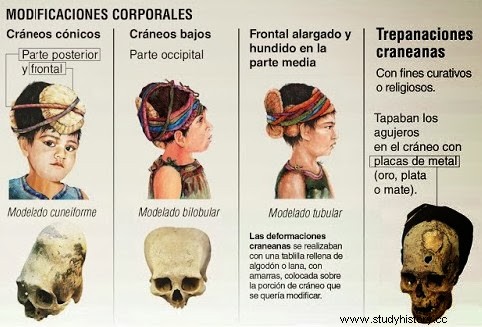The forensic anthropologist and researcher, John Verano, throughout his professional career has seen, studied and analyzed more than 800 skulls of ancient Peruvians who would have been intervened with the methodology called 'cranial trepanations'; praxis supported by the ancestral knowledge of the ancient Peruvians who constituted the pre-Inca civilizations.Verano, a specialist in examining mummies, skeletons from all over ancient America, applies the most sophisticated tools to decipher the secrets that surround human sacrifices, war wounds and diseases of the time.
 The questions that John Verano asks are the following:Why did the Inca doctors They operated on the skull of the ancient inhabitants of Peru up to seven times while they were still alive? What type of anesthesia did they use?
The questions that John Verano asks are the following:Why did the Inca doctors They operated on the skull of the ancient inhabitants of Peru up to seven times while they were still alive? What type of anesthesia did they use? HISTORY: The forensic anthropologist, Verano, narrates that 100 years ago, the Yale expedition that discovered and showed the world the world wonder, Machu Picchu, also discovered something mysterious. Members of the excursion team entered a cave in order to unearth some mummies and discovered the skeleton of a very strange Inca. Something that caught our attention was a skull that had five homogeneous holes in different parts of the helmet (perfect circles). Time passed and various expeditions with national and foreign professionals were able to intervene, some legally and others illegally, countless of caves throughout the Peruvian geography in order to unearth skeletons, mummies and carry out evaluations and studies regarding these surgical interventions on the head (skull) of the ancient Peruvians. All these discoveries threw up more mysteries that up to now cannot be solved, and honestly, I think they never will be, since there is no more evidence. However, the investigator, John, was able to access files and evidence that any other professional would have wanted to have in their hands.[…] Verano and a colleague managed to see some intervened skulls for the first time in 2002, when they visited a museum in the city of Cusco, which is located at an altitude of 11,000 feet […]Thanks to that visit, these researchers were able to analyze, study and photograph skulls of ancient Peruvians who had undergone surgery with the famous medical praxis, 'cranial trepanation', according to what was published in the report by John Bonifield of CNN, 62 skulls, 41 with a single hole and 21 with two or three holes.

On the other hand, skulls with three or four large holes would represent the “remains ” intangibles of bloody war of conquest from one culture to another, in addition, these fractures would prove the fatality of the ancient weapons of war, until the swords and sabers of the Spaniards arrived. After reading Verano's deduction, it leads us to think that the number of people with cranial brain injuries, forced -at the beginning of this expertise- to improvise to intervene the injured urgently, and with the passage of time, to improve the medical experience to save the lives of patients they were usually warriors who had been wounded on the battlefield. “There are many cases where there is a hole in the skull, and right next to it is a fracture line that extends out,” he reports.[…] One man had the entire top left of his skull scraped with a stone blade. The surgery was one of the first of its kind performed in the Americas, some 2,400 years ago […]“Somebody examines a patient like you might clean the wound and then take a look. If there were fractures and pieces of bone, they could carefully remove them,” said Verano.

These surgeries had a 40% survival rate in their early stage, but with time Over time, the Incas would have improved their technique and reached an amazing 80% survival rate. On the other hand, at that same time -700 to 500 years ago- this type of surgery was performed -in Europe- with metal probes and drills. Even Hippocrates wrote a manual to intervene this type of head fractures. “For the next 2,000 years, isolated from the rest of the world, Andean surgeons scraped, cut and drilled the heads of injured patients to clean a wound, or to disappear. blood clots or lower swelling. That practice is called trepanation.”“At a certain point in the time of the Incas, 500 to 700 years ago with the most advanced and consistent techniques, they were able to achieve thrust survival rates of 80%.”“It has been a very hands-on approach to head injuries, and it worked,” said Verano. “Undoubtedly, it was as good or better than neurosurgery until very recent times.” “This medical praxis disappeared as soon as the Spanish colonized and conquered the Inca culture, putting an end to 20 centuries of traditional medicine.”
OPINION: The cranial trepanations, especially those of the Paracas civilization, which developed south of the current capital city, Lima, Peru, are shrouded in mystery, and some historians and specialists assure that these surgical interventions in the skull of the ancient Peruvians, they would have been made by some sacred ritual, on the other hand, there is another hypothesis that is supported by a skull with an open portal; for:1).- improve oxygenation or blood flow, 2).- find more wisdom and intelligence. The hypotheses are very far-fetched, however, there is no evidence in this regard.
BUT HERE COMES THE BEST. After John Verano has studied cranial trepanation for more than 25 years, especially regarding the various holes (4,5,6,7) that some skulls have, he suggests that:“It is possible that they were made to try to alleviate “It is possible that they were done to try to relieve headaches or dizziness, but there is no evidence, and there never will be, I deduce that the cranial trepanations could have been a kind of ancient aspirin.”
[Credits. With information:edition.cnn.com, yale.edu, Harvard University Press │ Cover photo:Harvard University Press]
